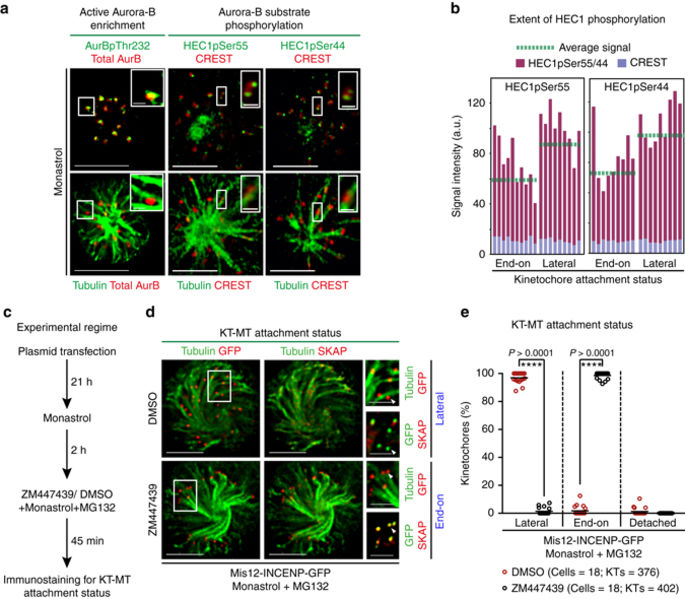当前位置:
X-MOL 学术
›
Nat. Commun.
›
论文详情
Our official English website, www.x-mol.net, welcomes your
feedback! (Note: you will need to create a separate account there.)
Aurora-B kinase pathway controls the lateral to end-on conversion of kinetochore-microtubule attachments in human cells.
Nature Communications ( IF 14.7 ) Pub Date : 2017-07-28 , DOI: 10.1038/s41467-017-00209-z Roshan L Shrestha 1, 2 , Duccio Conti 1, 3 , Naoka Tamura 1, 4 , Dominique Braun 1 , Revathy A Ramalingam 3 , Konstanty Cieslinski 5 , Jonas Ries 5 , Viji M Draviam 1, 3
Nature Communications ( IF 14.7 ) Pub Date : 2017-07-28 , DOI: 10.1038/s41467-017-00209-z Roshan L Shrestha 1, 2 , Duccio Conti 1, 3 , Naoka Tamura 1, 4 , Dominique Braun 1 , Revathy A Ramalingam 3 , Konstanty Cieslinski 5 , Jonas Ries 5 , Viji M Draviam 1, 3
Affiliation

|
Human chromosomes are captured along microtubule walls (lateral attachment) and then tethered to microtubule-ends (end-on attachment) through a multi-step end-on conversion process. Upstream regulators that orchestrate this remarkable change in the plane of kinetochore-microtubule attachment in human cells are not known. By tracking kinetochore movements and using kinetochore markers specific to attachment status, we reveal a spatially defined role for Aurora-B kinase in retarding the end-on conversion process. To understand how Aurora-B activity is counteracted, we compare the roles of two outer-kinetochore bound phosphatases and find that BubR1-associated PP2A, unlike KNL1-associated PP1, plays a significant role in end-on conversion. Finally, we uncover a novel role for Aurora-B regulated Astrin-SKAP complex in ensuring the correct plane of kinetochore-microtubule attachment. Thus, we identify Aurora-B as a key upstream regulator of end-on conversion in human cells and establish a late role for Astrin-SKAP complex in the end-on conversion process.Human chromosomes are captured along microtubule walls and then tethered to microtubule-ends through a multi-step end-on conversion process. Here the authors show that Aurora-B regulates end-on conversion in human cells and establish a late role for Astrin-SKAP complex in the end-on conversion process.
中文翻译:

Aurora-B 激酶通路控制人体细胞中着丝粒-微管附着的横向到末端的转换。
人类染色体沿着微管壁(横向附着)捕获,然后通过多步骤端上转换过程束缚到微管末端(端上附着)。协调人类细胞着丝粒-微管附着平面这一显着变化的上游调节因子尚不清楚。通过跟踪着丝粒运动并使用特定于附着状态的着丝粒标记,我们揭示了 Aurora-B 激酶在延缓末端转换过程中的空间定义作用。为了了解 Aurora-B 活性如何被抵消,我们比较了两种外着丝粒结合磷酸酶的作用,发现 BubR1 相关的 PP2A 与 KNL1 相关的 PP1 不同,在末端转化中发挥着重要作用。最后,我们发现了 Aurora-B 调节的 Astrin-SKAP 复合物在确保动粒-微管附着平面正确方面的新作用。因此,我们确定 Aurora-B 是人类细胞端上转化的关键上游调节因子,并确定了 Astrin-SKAP 复合物在端上转化过程中的后期作用。人类染色体沿着微管壁被捕获,然后束缚在微管上-通过多步骤的端到端转换过程结束。在这里,作者表明 Aurora-B 调节人类细胞的末端转化,并确定 Astrin-SKAP 复合物在末端转化过程中的后期作用。
更新日期:2017-07-30
中文翻译:

Aurora-B 激酶通路控制人体细胞中着丝粒-微管附着的横向到末端的转换。
人类染色体沿着微管壁(横向附着)捕获,然后通过多步骤端上转换过程束缚到微管末端(端上附着)。协调人类细胞着丝粒-微管附着平面这一显着变化的上游调节因子尚不清楚。通过跟踪着丝粒运动并使用特定于附着状态的着丝粒标记,我们揭示了 Aurora-B 激酶在延缓末端转换过程中的空间定义作用。为了了解 Aurora-B 活性如何被抵消,我们比较了两种外着丝粒结合磷酸酶的作用,发现 BubR1 相关的 PP2A 与 KNL1 相关的 PP1 不同,在末端转化中发挥着重要作用。最后,我们发现了 Aurora-B 调节的 Astrin-SKAP 复合物在确保动粒-微管附着平面正确方面的新作用。因此,我们确定 Aurora-B 是人类细胞端上转化的关键上游调节因子,并确定了 Astrin-SKAP 复合物在端上转化过程中的后期作用。人类染色体沿着微管壁被捕获,然后束缚在微管上-通过多步骤的端到端转换过程结束。在这里,作者表明 Aurora-B 调节人类细胞的末端转化,并确定 Astrin-SKAP 复合物在末端转化过程中的后期作用。






























 京公网安备 11010802027423号
京公网安备 11010802027423号